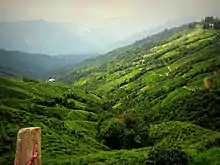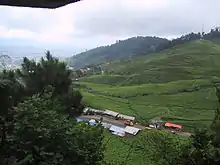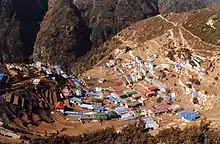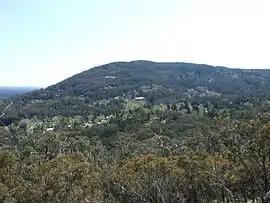Hill station
A hill station is a town located at a higher elevation than the nearby plain or valley. The term was used mostly in colonial Asia (particularly in India), but also in Africa (albeit rarely), for towns founded by European emigrants as refuges from the summer heat, up where temperatures are cooler. In the Indian context, most hill stations are at an altitude of approximately 1,000 to 2,500 metres (3,300 to 8,200 ft); very few are outside this range.
History
British India
Hill stations in British India were established for a variety of reasons. One of the first reasons in the early 1800s, was for the place to act as a sanitorium for the ailing family members of British officials.[1] After the rebellion of 1857, the British "sought further distance from what they saw as a disease-ridden land by [escaping] to the Himalayas in the north". Other factors included anxieties about the dangers of life in India, among them "fear of degeneration brought on by too long residence in a debilitating land". The hill stations were meant to reproduce the home country, illustrated in Lord Lytton's statement about Ootacamund, in the 1870s as having "such beautiful English rain, such delicious English mud."[2] Shimla was officially made the "summer capital of India" in the 1860s and hill stations "served as vital centers of political and military power, especially after the 1857 revolt."[3][4]
Dane Kennedy, following Monika Bührlein, identifies three stages in the evolution of hill stations in India: high refuge, high refuge to hill station, and hill station to town. The first settlements started in the 1820s, primarily as sanitoria. In the 1840s and 1850s, there was a wave of new hill stations, with the main impetus being "places to rest and recuperate from the arduous life on the plains". In the second half of the 19th century, there was a period of consolidation with few new hill stations. In the final phase, "hill stations reached their zenith in the late nineteenth century. The political importance of the official stations was underscored by the inauguration of large and costly public-building projects."[3]:14
List of hill stations
Most hill stations, listed by region:
Nigeria
Uganda
Brazil
Costa Rica
United States
Bangladesh

Hong Kong
India
Hundreds of hill stations are located in India. The most popular hill stations include:

.jpg.webp)

.jpg.webp)
- Achabal, Jammu and Kashmir
- Amarkantak, Madhya Pradesh
- Ambanad Hills, Kerala
- Amboli, Maharashtra
- Almora, Uttarakhand
- Araku Valley, Andhra Pradesh
- Aritar, Sikkim
- Aru, Jammu and Kashmir
- Askot, Uttarakhand
- Auli, Uttarakhand
- Baba Budan giri, Karnataka
- Badrinath, Uttarakhand
- Baltal, Jammu and Kashmir
- Barog, Himachal Pradesh
- Berinag, Uttarakhand
- Bhaderwah, Jammu and Kashmir
- Bhowali, Uttarakhand
- Chail, Himachal Pradesh
- Chakrata, Uttarakhand
- Chamba, Himachal Pradesh
- Champhai, Mizoram
- Chaukori, Uttarakhand
- Cherrapunjee, Meghalaya
- Chikhaldara, Maharashtra
- Chitkul, Himachal Pradesh
- Coonoor, Tamil Nadu
- Daksum, Jammu and Kashmir
- Dalhousie, Himachal Pradesh
- Daringbadi, Odisha
- Darjeeling, West Bengal
- Dawki, Meghalaya
- Diskit, Ladakh
- Doodhpathri, Jammu and Kashmir
- Dhanaulti, Uttarakhand
- Dharamkot, Himachal Pradesh
- Dharchula, Uttarakhand
- Dras, Ladakh
- Dzuluk, Sikkim
- Dzüko Valley, Nagaland and Manipur
- Gairsain, Uttarakhand
- Gangtok, Sikkim
- Ghum, West Bengal
- Gulmarg, Jammu and Kashmir
- Geyzing, Sikkim
- Haflong, Assam
- Hemkund Sahib, Uttarakhand
- Hmuifang, Mizoram
- Kalpa, Himachal Pradesh
- Jogindernagar, Himachal Pradesh
- Jogimatti, Karnataka
- Joshimath, Uttarakhand
- Kalimpong, West Bengal
- Katra, Jammu and Kashmir
- Kangra, Himachal Pradesh
- Kargil, Ladakh
- Karzok, Ladakh
- Kedarnath, Uttarakhand
- Keylong, Himachal Pradesh
- Khajjiar, Himachal Pradesh
- Kodaikanal, Tamil Nadu
- Kohima, Nagaland
- Kokernag, Jammu and Kashmir
- Khandala, Maharashtra
- Kufri, Himachal Pradesh
- Kullu, Himachal Pradesh
- Kurseong, West Bengal
- Lachen, Sikkim
- Lachung, Sikkim
- Lansdowne, Uttarakhand
- Lava, West Bengal
- Leh, Ladakh
- Lonavala, Maharashtra
- Lolegaon, West Bengal
- Lunglei, Mizoram
- Mahabaleshwar, Maharashtra
- Mainpat, Chhattisgarh
- Matheran, Maharashtra
- Manali, Himachal Pradesh
- Mawsynram, Meghalaya
- McLeod Ganj, Himachal Pradesh
- Meghamalai, Tamil Nadu
- Mirik, West Bengal
- Mount Abu, Rajasthan
- Murgo, Ladakh
- Munnar, Kerala
- Munsiyari, Uttarakhand
- Mussoorie, Uttarakhand
- Nainital, Uttarakhand
- Narkanda, Himachal Pradesh
- New Tehri, Uttarakhand
- Ooty(Udhagamandalam), Tamil Nadu
- Pachmarhi, Madhya Pradesh
- Palampur, Himachal Pradesh
- Pahalgam, Jammu and Kashmir
- Patnitop, Jammu and Kashmir
- Pauri, Uttarakhand
- Pelling, Sikkim
- Pfutsero, Nagaland
- Pithoragarh, Uttarakhand
- Ramgarh, Uttarakhand
- Ranikhet, Uttarakhand
- Reckong Peo, Himachal Pradesh
- Reiek, Mizoram
- Rishyap, West Bengal
- Samsing, West Bengal
- Saputara, Gujarat
- Shillong, Meghalaya
- Shimla, Himachal Pradesh
- Sonamarg, Jammu and Kashmir
- Soordelu Hill Station, Kerala
- Tawang, Arunachal Pradesh
- Thekkady, Kerala
- Triund, Himachal Pradesh
- Tosa Maidan, Jammu and Kashmir
- Turtuk, Ladakh
- Uttarkashi, Uttarakhand
- Vagamon, Kerala
- Verinag, Jammu and Kashmir
- Wilson Hills, Gujarat
- Yusmarg, Jammu and Kashmir
- Yuksom, Sikkim
- Yumthang, Sikkim
Indonesia

- Garut in, West Java
- Puncak in West Java
- Batu in East Java
- Tretes in East Java
- Kaliurang in Central Java
- Munduk in Bali
- Bedugul in Bali
- Berastagi in North Sumatra
- Lembang in West Java
- Baturaden in Central Java
- Wonosobo in Central Java
- Tawangmangu in Central Java
- Bandungan, Semarang in Central Java
- Bukittinggi in West Sumatra
- Padang Panjang in West Sumatra
- Sawahlunto in West Sumatra
- Solok in West Sumatra
- Payakumbuh in West Sumatra
- Takengon in Aceh
- Tomohon in North Sulawesi
- Tana Toraja in South Sulawesi
- Malino in South Sulawesi
- Salatiga in Central Java
Jordan
- A few suburbs in Amman
Malaysia
.jpg.webp)
Myanmar
Nepal

Pakistan
Khyber Pakhtunkhwa
Punjab
Sindh
Balochistan
Gilgit Baltistan
Czech Republic
Australia


Victoria
South Australia
Queensland
Western Australia
New South Wales
See also
References
- Dane Keith Kennedy (1996). The Magic Mountains: Hill Stations and the britishBritishRaj. University of California Press. p. 24. ISBN 978-0-520-20188-0.
- Barbara D. Metcalf; Thomas R. Metcalf (2002). A Concise History of India. Cambridge University Press. p. 111. ISBN 978-0-521-63974-3.
- Kennedy, Dane (1996). The Magic Mountains: Hill Stations and the British Raj. Berkeley: University of California Press. Retrieved 19 Aug 2014.
- Vipin Pubby (1996). Shimla Then and Now. Indus Publishing. pp. 17–34. ISBN 978-81-7387-046-0. Retrieved 16 August 2013.
- Walters, Trudie; Duncan, Tara (2 Oct 2017). Second Homes and Leisure: New perspectives on a forgotten relationship. Abingdon-on-Thames: Routledge. ISBN 9781317400264.
Bibliography
| External video | |
|---|---|
- Crossette, Barbara. The Great Hill Stations of Asia. ISBN 0-465-01488-7.
- Kennedy, Dane. The Magic Mountains: Hill Stations and the British Raj (Full text, searchable). Berkeley: University of California Press, 1996. ISBN 0-520-20188-4, ISBN 978-0520201880.
External links
 Media related to Hill stations at Wikimedia Commons
Media related to Hill stations at Wikimedia Commons The dictionary definition of hill station at Wiktionary
The dictionary definition of hill station at Wiktionary- Hill Stations in Nepal










